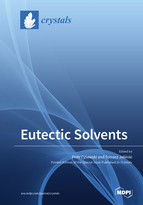Eutectic Solvents
A special issue of Crystals (ISSN 2073-4352). This special issue belongs to the section "Macromolecular Crystals".
Deadline for manuscript submissions: closed (30 September 2020) | Viewed by 22829
Special Issue Editors
Interests: theoretical chemistry; in silico modeling; solution thermodynamics; new materials screening
Special Issues, Collections and Topics in MDPI journals
Interests: solubility of pharmaceuticals; natural deep eutectic solvents; ionic liquids; binary solvents; solution thermodynamics
Special Issues, Collections and Topics in MDPI journals
Special Issue Information
Dear Colleagues,
Eutectic molecular liquids (EMLs) as functional liquid media have attracted great attention for their extreme broad range of applications granted from their special and tunable properties. Thousands of research projects have been successively launched, revolutionizing, among others such areas, green chemistry formulations, organic synthesis and catalysis, alternative media for metal processing, selective purification with extraction and micro-extraction, recovery of natural products, effective dissolution media, cosmetic and pharmaceutical formulations, biorenewable polymers processing, energy storage and energy transportation, nanofluids, nanomaterials preparation, supercapacitors, and luminescent materials or electrochromic devices.
This variety of applications originated from a diversity of possible formulations encompassing simple molecular eutectic systems, eutectic metal and organic alloys, ionic liquids (ILs), deep eutectic solvents (DES) and also natural deep eutectic solvents (NADES). Apart from experimental studies, new theoretical issues have emerged around in silico modeling, including quantum chemistry approaches, molecular dynamic studies, and linear and nonlinear modeling, including QSPR and neural networks.
We invite researchers to seize this opportunity to take part of a unique multidisciplinary forum covering broad theoretical and practical aspects of EMLs and to contribute to the Special Issue on eutectic solvents not only to comprehensively review and systematize accumulated knowledge but also to present new features worth sharing with the scientific community.
The potential topics include but are not limited to EMLs:
- Synthesis and stability;
- Properties, including bioproperties;
- Instrumental characteristics;
- Theoretical considerations;
- Structure to properties relationships;
- Practical applications.
Prof. Piotr Cysewski
Dr. Tomasz Jeliński
Guest Editors
Manuscript Submission Information
Manuscripts should be submitted online at www.mdpi.com by registering and logging in to this website. Once you are registered, click here to go to the submission form. Manuscripts can be submitted until the deadline. All submissions that pass pre-check are peer-reviewed. Accepted papers will be published continuously in the journal (as soon as accepted) and will be listed together on the special issue website. Research articles, review articles as well as short communications are invited. For planned papers, a title and short abstract (about 100 words) can be sent to the Editorial Office for announcement on this website.
Submitted manuscripts should not have been published previously, nor be under consideration for publication elsewhere (except conference proceedings papers). All manuscripts are thoroughly refereed through a single-blind peer-review process. A guide for authors and other relevant information for submission of manuscripts is available on the Instructions for Authors page. Crystals is an international peer-reviewed open access monthly journal published by MDPI.
Please visit the Instructions for Authors page before submitting a manuscript. The Article Processing Charge (APC) for publication in this open access journal is 2600 CHF (Swiss Francs). Submitted papers should be well formatted and use good English. Authors may use MDPI's English editing service prior to publication or during author revisions.
Keywords
- Functional Liquid Media (FLM)
- Eutectic Mixtures (EM)
- Ionic Liquids (IL)
- Deep eutectic solvents (DES)
- Natural deep eutectic solvents (NADES)







